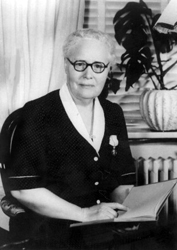
Maria Jacobsen was born in Siim, a small city in Denmark, on November 6, 1882. She was very young when she learnt about the Hamidian massacres (1894-1896) and sufferings of the Armenian people in the Ottoman Empire from the articles published in Danish media.
The members of the phil-Armenian movement, that began in 1890s in the Scandinavian countries and particularly in Denmark, had various enterprises and made speeches condemning the Hamidian massacres. The Danish branch of the "Women’s Missionary Workers" (K.M.A.) Organization was established in Denmark in 1900: it supported Armenian orphans sheltered in German orphanages of Mush, Van, Marash and Kharberd. In 1906 after completing nursing courses, Maria Jacobsen became a member of the "Women’s Missionary Workers" Organization and left for Kharberd as a missionary to help suffering Armenian people. In November 1907 the young missionary arrived in Kharberd where she was appointed as a director at a small hospital. In a short period she learnt Armenian in order to communicate with local people. At the same time she began writing her diary, which later became a valuable eyewitness testimony of the Armenian Genocide. Maria Jacobsen left her first record in the diary on September 7, 1907, and the last one was dated August 6, 1919. The voluminous diary which has 600 pages mainly presents the deportation and exile of the Armenians of Kharberd and scenes of murders ferociously perpetrated by the Turks from 1915 to 1919. For a long time the Danish missionary who was an eyewitness to the Armenian Genocide kept her diary in a secret as she had taken it out of the Ottoman Empire endangering her life. Maria Jacobsen’s diary was translated into Armenian and after her death it was published in Beirut in 1979.
In 1919 after World War I in a few months with the support of the Near East Relief workers Maria Jacobsen collected more than 3600 Armenian orphans, the most of whom were suffering from infectious diseases; they were wandering in the different parts of the shattering empire emaciated by hunger and raw-boned.
In 1919 because of health problems Maria Jacobsen (she had been infected with typhus from orphans) decided to leave for Denmark, but on her way home she got an invitation to visit the United States. She had public lectures on the massacres committed against the Armenian people in the Ottoman Empire in different cities of USA and raised money for the Armenian orphans during those 7 months of her stay in the States. In 1920-1921 Maria Jacobsen tried to go back to Kharberd, but Turkish authorities did not permit her to enter the Ottoman Empire; thus she moved to Beirut and continued her activity in Lebanon.
In 1919-1922 a new wave of persecutions against the Armenian refugees, especially for the orphans, rose in Turkey, and many children were taken to the Turkish state orphanages. On this occasion the Near East Relief initiated evacuation of 110.000 Armenian orphans from the Ottoman Empire to Russia, Eastern Armenia, Lebanon, Syria and Greece. In January 1922, Maria Jacobsen transferred a large group of orphans to Beirut together with another Danish missionary Karen Marie Petersen. In July1922 she settled in Zouk Michail which was between the cities of Byblos and Beirut (this was the first orphanage of K.M.A.) with 208 children from Cilicia. Later they moved to Sayda. The smallest of the Armenian orphans got care and attention here.
In 1928 the "Women’s Missionary Workers" Organization (K.M.A.) acquired the building of the Armenian orphanage of Jbeil from the American Near East Relief, where the Danish orphanage “Birds’ Nest” was established. The Armenian orphans referred to Maria Jacobsen as “Mama Jacobsen”. By its status “Birds’ Nest” was rather like a school, than an orphanage. There children were taught the same subjects as at public schools of Lebanon together with different crafts.
Humanitarian activity of Maria Jacobsen got a deserved appraisal in Denmark. In 1950 she was awarded the golden medal of the Danish Kingdom. Moreover, she was the first female in Denmark who got that highest state award. In 1954 Maria Jacobsen was granted the Gold Medal of Honor by the Lebanese Government.
Maria Jacobsen died on April 6, 1960, and by her will, she was buried in the courtyard of Birds' Nest. “Mama Jacobsen” educated thousands of orphans as true Armenians. They became clergymen, physicians, teachers and just good individuals.
In 2010 the Armenian Genocide Museum-Institute received materials―personal belongings, unpublished photos, reports, postcards and etc.― from Maria Jacobsen’s archives as a donation.
The album and handwritten diary of Maria Jacobsen are in Lebanon, but the missionary reports, accounts, photos, etc. are in the Danish archives of K.M.A.
The Armenian Genocide Museum-Institute issued a jubilee postcard on the occasion of the 130th birth anniversary of Maria Jacobsen.
Gohar Khanumyan
Head of Library of Armenian Genocide Museum-Institute





